THE BACKYARD HOMESTEAD
guide to Raising
Raising
FARM ANIMALS
The mission of Storey Publishing is to serve our customers by publishing practical information that encourages personal independence in harmony with the environment.
Edited by Sarah Guare
Art direction by Dan O. Williams
Book design and text production by MacFadden and Thorpe
Cover illustration and illustrations on pages i-vi by Michael Austin, Jing and Mike Company Interior illustration credits appear on page 340
Indexed by Andrea Chesman
Expert review of the rabbit chapter by Bob Bennett, the sheep chapter by Carol Ekarius, the turkey chapter by Eugene Morton, and the cattle chapter by Mary Sherman
2011 by Storey Publishing, LLC
Sections of this book previously appeared in the following books by Storey Publishing: Barnyard in Your Backyard, edited by Gail Damerow; Storeys Guide to Keeping Honey Bees, by Malcolm T. Sanford and Richard E. Bonney; and Storeys Guide to Raising Pigs, by Kelly Klober.
All rights reserved. No part of this book may be reproduced without written permission from the publisher, except by a reviewer who may quote brief passages or reproduce illustrations in a review with appropriate credits; nor may any part of this book be reproduced, stored in a retrieval system, or transmitted in any form or by any meanselectronic, mechanical, photocopying, recording, or otherwithout written permission from the publisher.
The information in this book is true and complete to the best of our knowledge. All recommendations are made without guarantee on the part of the author or Storey Publishing. The author and publisher disclaim any liability in connection with the use of this information.
Storey books are available for special premium and promotional uses and for customized editions. For further information, please call 1-800-793-9396.
Storey Publishing
210 MASS MoCA Way
North Adams, MA 01247
www.storey.com
Printed in the United States by Versa Press
10 9 8 7 6 5 4 3 2 1
Library of Congress Cataloging-in-Publication Data
The backyard homestead guide to raising farm animals / edited by Gail Damerow.
p. cm.
Includes index.
Previously published as: Barnyard in your backyard. North Adams, MA : Storey Pub., c2002.
ISBN 978-1-60342-969-6 (pbk. : alk. paper)
1. Domestic animals. 2. Food animals. I. Damerow, Gail.
SF61.B23 2011
636dc22
2010051172
THE BACKYARD HOMESTEAD
guide to Raising
FARM ANIMALS

Edited by Gail Damerow
Contributing Authors:
Richard E. Bonney, Gail Damerow, Kelly Klober, Darrell L. Salsbury, Malcolm T. Sanford, Nancy Searle, Paula Simmons, Heather Smith Thomas

Contents
Preface

I did not grow up on a farm. My father was a town boy. My mother was raised in the country, left at her first opportunity, and never looked back. I have fond memories of visiting my grandmother and her big flock of laying hens; of watching an uncle milk his cows; of briefly, while my parents built a new house, living in a rented country house with pigs across the road and a goat next door that surprised and delighted me one noon by poking its head through the kitchen window hoping to snatch a bite of my sandwich. These and similar events made me determined to someday have farm animals of my own.
And so when I came of age I started out with chickens, soon followed by ducks and geese and other poultry. Then came rabbits. Then I had to have goats. In the decades that followed I have, at one time or another, raised nearly every species of farm animal. At first I did it just for fun. Before long I realized I had ready access to eggs, milk, and meat that were fresher and better tasting than anything available at the store. I have been grateful for these resources during the several economic crises that have occurred over the years, and especially today in the face of growing concern about the safety of industrially produced food.
I didnt have any background in farming or raising livestock, and by the time I was ready to seek their advice no farmers were left in my family. I gleaned most of my start-up information from books, and the rest I learned simply by rolling up my sleeves and jumping into what has become a life-long and ongoing learning experience. My point is that you need not have grown up on a farm to raise farm animals. This book is offered as your first step toward enjoying the rewarding experience of keeping livestock of your own and to assure youyou can do it!
Gail Damerow
Introducing Backyard Farm Animals
Food security. The term means different things to different people. One definition involves having a reliable source of basic foods and not having to worry about going hungry. Another requires the food to be of sufficient quantity and quality to meet your dietary needs and satisfy your food preferences. Still other definitions specify that the food be nutritious, safe, and healthful. And some definitions incorporate the concepts of local self-sufficiency and environmental sustainability.
Taken together, these various definitions point in one direction: Grow your own. And unless you are a vegetarian, that means raising livestock. As a lot of people are learning, you dont need to live on a farm to raise food animals. A pair of rabbits in the carport or on the back porch will provide a year-round supply of meat while taking up hardly any space at all. A beehive or two will give you healthful honey while pollinating your garden. A few hens will provide you with fresh eggs while living happily in one corner of the garden. When I started out with livestock, I lived on approximately one acre on which I raised a variety of rabbits, chickens, turkeys, ducks, and geese, along with a big garden and a small orchard. The garden and orchard benefited from the manure produced by the animals, and the animals benefited from surplus produce gleaned from the garden. Best of all, my family enjoyed food security of the highest order.
Today I live on a farm, where we have space to raise more food animals. We keep dairy goats for their delicious milk, and on occasion use surplus milk to raise a calf for awesomely tasty homegrown burgers or to raise piglets that fill our freezer with succulent pork. But you dont have to live on a farm, or even on one acre of land, to produce nutritious, safe, healthful eggs, milk, and meat. This book is here to point the way.
Why Raise Food Animals?
Aside from supplying wholesome eggs, milk, meat, and honey, keeping farm animals has another health benefit. Observing the sight and sounds of the animals in your yard offers a refreshing, stress-reducing change from the scurry of modern life. Provided you leave the cell phone behind, doing barnyard chores is a great way to take time out for relaxation and quiet enjoyment. Since livestock must be cared for daily, they pull you away from your indoor activities and force you to get out for a little exercise and fresh air. I often spend long days in the office and look forward to doing evening chores that not only let me stretch my muscles but also help clear my head.
Next page

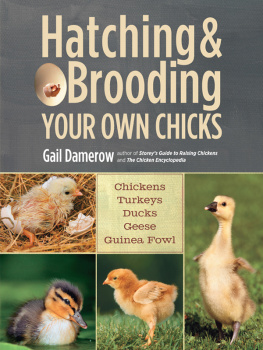

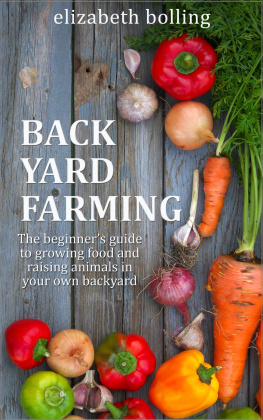
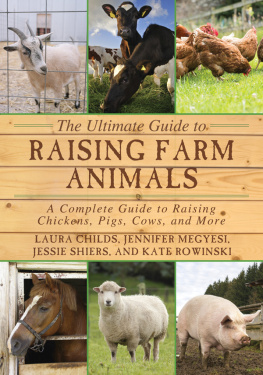
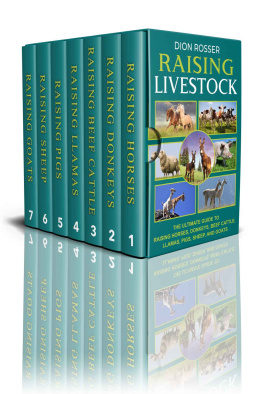
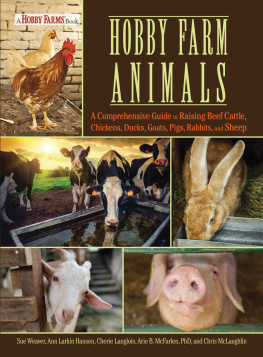
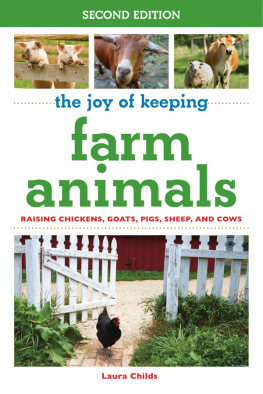
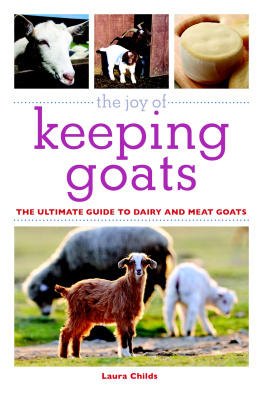
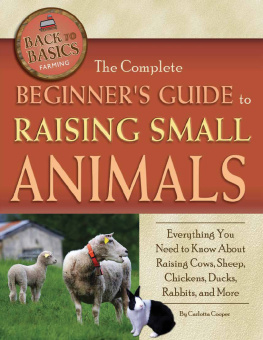
 Raising
Raising

